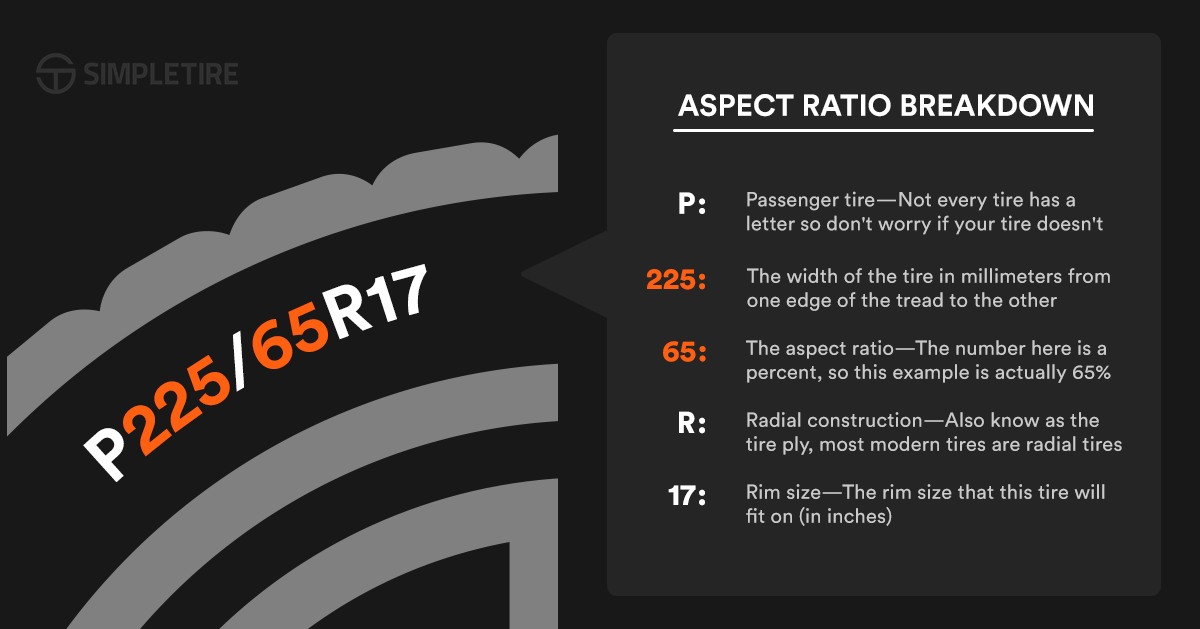Tire buying guides
Best price guarantee
Tire replacement coverage
24/7 roadside assistance
Easy returns
Your tire aspect ratio is part of codes and numbers on your tire’s sidewall, but what does the term “aspect ratio” even mean?
The simplest explanation is that the aspect ratio tells you how much sidewall is visible on your tire. It’s a little more complicated than that—and finding the exact numbers requires some math—but if you can punch some numbers into a calculator then you’ll be able to figure this one out pretty easily.
So, what does tire aspect ratio mean?

The orange numbers above are the only numbers that we'll need to figure out how tall your sidewall is. The numbers on your tires may be different, but in the example above we're going to use 225 and 65. Remember that 225 is measured in millimeters, and 65 is a percent then punch those numbers into a calculator: 225x0.65=146.25mm
Speaking of size, let’s clear up a couple of things about aspect ratio and tire size:
Is a taller sidewall better?
In most cases, the answer is an unequivocal yes. The taller sidewall means there’s more rubber there to cushion you against bumps, impacts, and road irregularities. You’re probably familiar with low profile tires, usually on bigger rims. Stylish and aesthetically pleasing, low profile tires can offer enhanced cornering and braking performance, but just realize that you’ll encounter other tradeoffs as well. They definitely have a nasty effect on ride quality and have less rubber to protect the rim against damage. Many drivers report a drop in fuel economy as well, along with added rolling resistance from the tires.
What is tire plus-sizing?
When you start changing the width and aspect ratio of your tires, there’s a definite formula to follow: the plus sizing formula. For each increment of width that you add, you should go down one increment in aspect ratio. For instance, if your original tires are 205/60R15 and you want to go wider, go to 215/55R15. Now, if you want to change rim height as well, you’ll need to change the aspect ratio again; you can go with 215/50R16. A plus two size would be 235/40R17, by this formula.
What are the advantages of plus-sizing?
Plus-sizing can mean improved braking and traction due to a bigger tire footprint. That can be important if you’ve got a high-horsepower, high-torque vehicle and you want that boost in traction for acceleration, connecting the tires to the pavement instead of wheelspin.
What are the disadvantages of plus-sizing?
Wider tires can mean added rolling resistance and poorer fuel economy. Many drivers have noted a poor return-to-center after rounding a corner, and on an ordinary vehicle, a wider tire can actually mean a drop in acceleration performance. Excessively wide tires can rub on the fender wells, and a taller wheel means an effective drop in the final drive ratio. That means that a taller wheel is turning slower to cover the same amount of ground as the original wheel size, which then makes your speedometer give an erroneous (slower) reading.
Another factor to bear in mind when plus-sizing rims and tires is unsprung weight. Like the name suggests, unsprung weight is anything that’s not actually supported by the suspension, meaning the spindles, brakes, discs, steering knuckles, axles, differential, wheels, and tires. The extra weight of bigger rims (unless you go for lightweight, expensive racing rims made from some exotic alloy) means more unsprung weight and more rotating mass that the braking system has to be able to arrest. In other words, bigger rims can (not always but can) mean a problem in braking performance.
Lots to consider
Even though wheels on newer vehicles keep getting bigger, the 15” rim is still the most common size among all the vehicles on the road today, with about 50% of all cars and light SUVs riding on 15s (16s are the next most common). Your ride does leave the factory with wheel and tire sizes that are determined by engineering teams for the best ride quality, handling, fuel efficiency, braking performance, and overall road manners. When you’re thinking about a change in tire sizes or wheel sizes, there are all kinds of variables to take into account and there’s a good chance you may run into some unintended consequences. It’s a good idea to do your homework thoroughly and consult with a professional before jumping the gun on any decision like that.
The good news is that if you’re thinking about plus-sizing or just changing tire sizes for a different aspect ratio, SimpleTire has plenty of tire options that will fit your vehicle, your preferences, and your budget! Just figure out what you need, what you want to spend, and let our search tools take you to the right tire for your vehicle.
Ready to find the perfect tires?
Search By